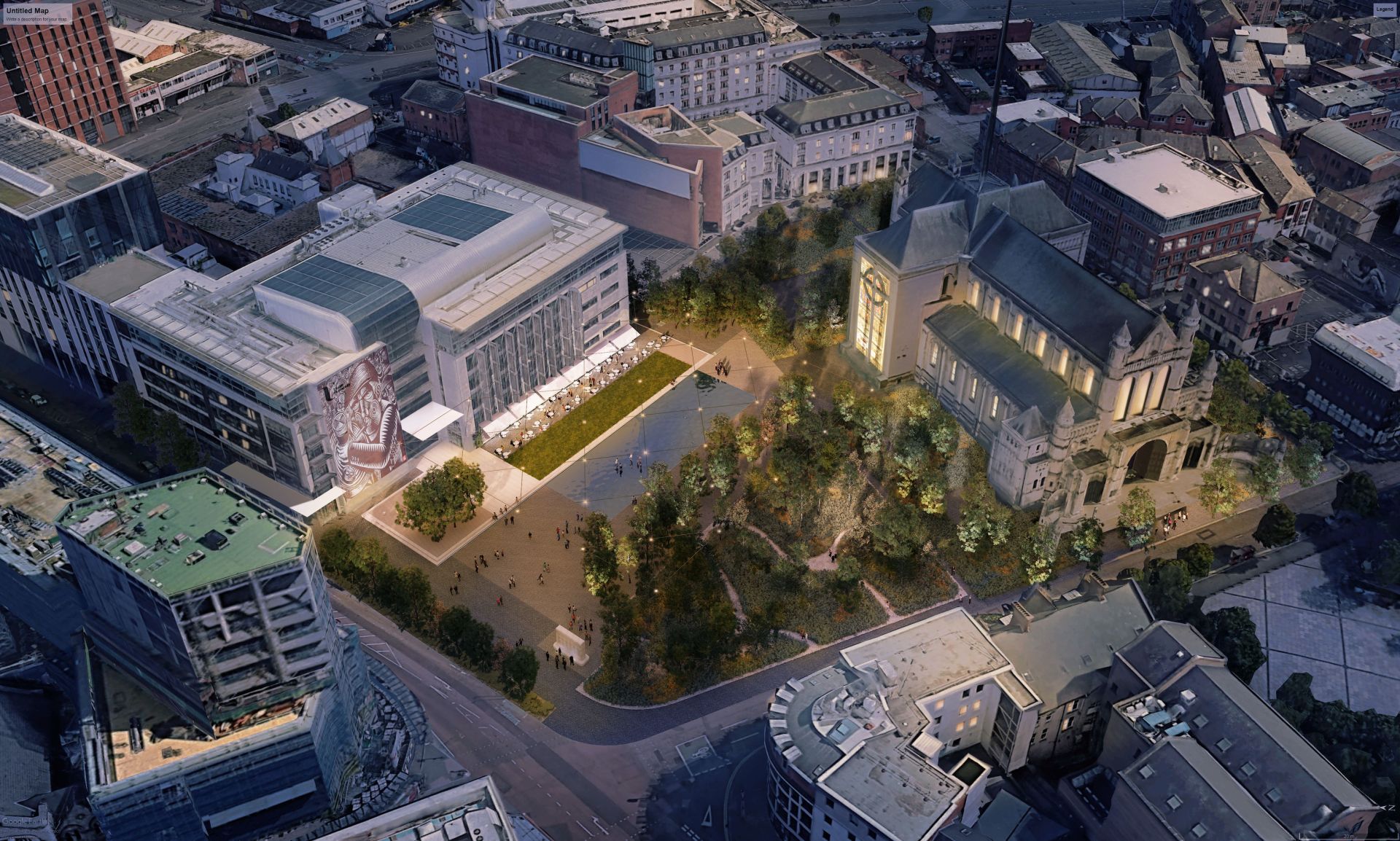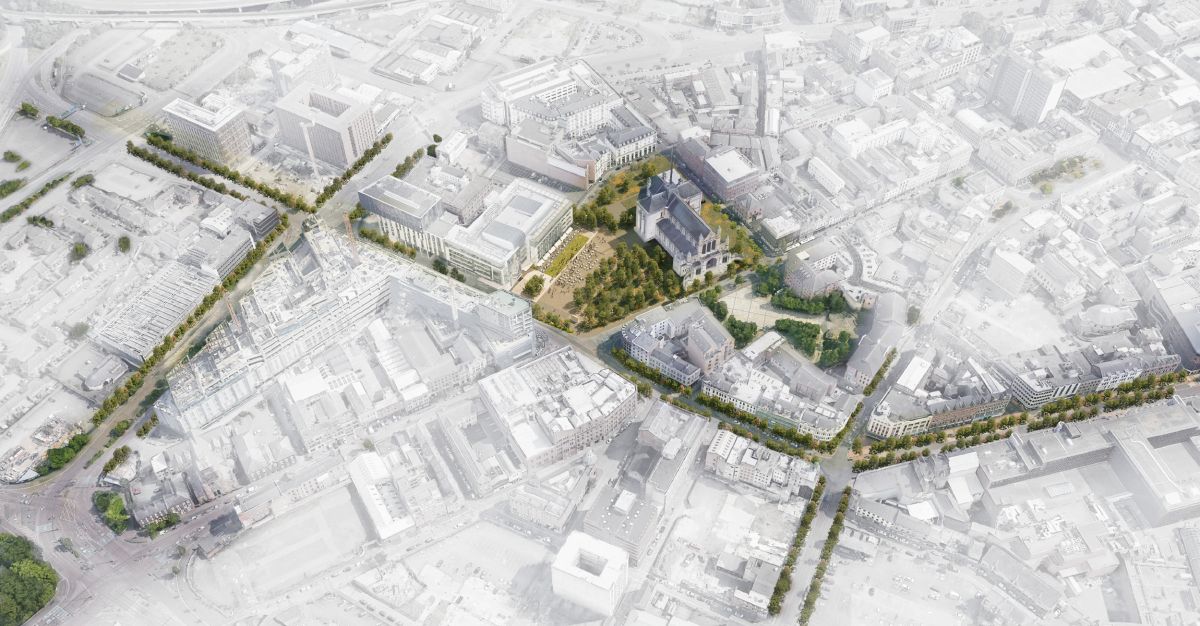Drawing outside the lines: reimagining Cathedral Gardens, Belfast

By understanding how a place is impacted by – and impacts – everything and everyone around it, the design process is elevated from a matter of opinion to a realisation of what matters.
“The project site is marked on the map by the red line.” From a financial and legal perspective, it makes sense that project boundaries should be clearly demarcated, to protect against any budget or liability disputes. But when we take a social, environmental, or indeed economic outlook, the idea of the red line as a protective barrier quickly loses all meaning. In fact, it’s more like a tripwire.
Since December 2020, we’ve been working with Belfast City Council to redesign one of the city’s most important — but also previously neglected — civic spaces. Cathedral Gardens is located in the heart of Belfast, next to Ulster university and the historic St Anne’s Cathedral. The 4570 m² site — two thirds the size of an average football pitch — is accessible by public transport as well as by foot and bike via key city centre streets. It links inwards to major civic and commercial destinations, and outwards to more residential neighbourhoods.
Delving into this project, we quickly discover that Cathedral Gardens is an example of a place, which cannot — and should not — be contained within its formal boundaries. The opportunities and challenges of this site provide an ideal opportunity to ‘draw outside the lines’ and inform the project from the outside-in.
Talking about Cathedral Gardens, Belfast
In this conversation, our Senior Researcher on Global Urban Resilience, Camilla Siggaard Andersen is joined by our Head of Landscape Architecture (UK) Angus Bruce and Belfast City Council’s project sponsor Frankie Smith to discuss the design approach to transforming Cathedral Gardens into a sustainable urban oasis.
Camilla Siggard Andersen: Frankie, Angus, you both know the Cathedral Gardens project better than anyone. Could you give us an introduction to the site?
Frankie Smith: Cathedral Gardens has a unique location in a neighbourhood that is going through a lot of change. It’s the last real civic space in that part of Belfast that we could do something exceptional with, and that’s what we’re striving for with this project.
Angus Bruce: It’s an amazing site with a great history behind it and an even greater future ahead. You could already see the potential bubbling to the surface in the brief that we responded to.
Frankie:
When we sent the brief out, Hassell’s response was so interesting. Instead of merely repeating what we’d said, they pushed us, and the site, further.
That was what we wanted; a design team that understood the wider opportunity, not just for Cathedral Gardens but for the city as well.
Camilla: It sounds like looking beyond the site boundary was in the cards for Cathedral Gardens from a very early stage. Is that normal for a Council-led project?
Frankie: Not exactly. There haven’t been many projects like this in the past. Though, more and more, we do try to push the envelope and we want to be more innovative. Cathedral Gardens is a good example of that, where we didn’t want to be too prescriptive with the brief and instead have kept an open mind for what might be possible.

Camilla: Angus, it’s my understanding that for Cathedral Gardens, you hardly drew anything on the site itself for at least the first month of working on the project. What was the logic behind that decision?
Angus: It wasn’t necessarily intentional – it was just the most sensible way to assess the site. We looked at the neighbourhood’s transport networks, parking provision, crime statistics, tree planting strategy, street art… All the things you would normally find in separate urban planning documents, for the sake of informing the landscape design requirements for this specific site. I think the benefits of taking this approach quickly became apparent to all parties involved.
Frankie: It has been a really interesting journey. Usually for a public site, there are a lot of pre-conceived ideas about what the place should be.
What Hassell has helped us understand is that what goes on the site should be determined by what is around it.
In addition to leading us towards a more evidence-based solution, this level of analysis has also created a much better stakeholder engagement experience. We have all been on the journey together.
Camilla: Angus, has that also been your experience?
Angus: Absolutely. It is clear that everyone loves the site, and people have been really receptive towards our approach. Instead of starting with a discussion about what the space itself could be, we have been closing in on the site from the outside in, making small decisions along the way. By the time we get to Cathedral Gardens, everyone’s already on the same page. We have been so uplifted after each stakeholder session.
Frankie: By leading with the evidence and showing a real contextual understanding, Angus and his team have completely won over the audience. I have not been in a consultation process before where it has gone so smoothly.
Camilla: Essentially, you are evolving the site by addressing everything that exists around it and bringing the stakeholders along in the process.
Angus: That’s right. And by organising the information in a balanced way, everyone has been able to find something that is important to them that the site can help deliver. Some people want to see a healthy city. Some people want a green city. For some, it is the culture or economic vibrancy that’s important. We’re not trying to make the site do everything, we just want it to do all the right things.
Camilla: And the red line?
Angus:
Public space has no boundary. People don’t experience a neighbourhood as fragmented sites. A boundary line is contractually right, but as a design boundary you can’t stop at the edge. Not if you want to achieve wider societal, economic, or environmental objectives.
We have even been proposing planting street trees and changing ground floor uses that are well outside the red line but necessary to help unlock the greater vision.
Frankie: Hassell has done a great job linking together multiple considerations. Normally, from a plan point of view, we love our red lines but it is great to work with a design team that won’t be confined by it.
Camilla: Looking ahead, I wonder what you might have learned from this project that you would like to carry forward?
Angus: I would love to take this approach and use it to tackle a collection of otherwise fragmented council sites across a city. With several places on the drawing table, the assets can be made to work together to create an interconnected and unified neighbourhood that really is greater than the sum of its parts.
Frankie: I would like to continue to work with design teams who challenge our thinking, and who know how to use evidence to create a more transparent design experience for everyone involved.
Hassell’s work on Cathedral Gardens represent the initial stages of the RIBA Plan of Work Stages 0 + 1 and Belfast City Council’s project vision, in a stepped process towards planning approval and ultimate construction and delivery of the new public realm. The Gardens will go through concept design and public consultation next.
BEYOND THE DESIGN BRIEF
The Cathedral Gardens project exemplifies the benefits to be reaped from drawing beyond the red line set by a design brief. With this ‘outside-in’ approach, everything and everyone around the site becomes the key to unlocking wider outcomes, and the thread for stitching together disparate neighbourhood strategies.